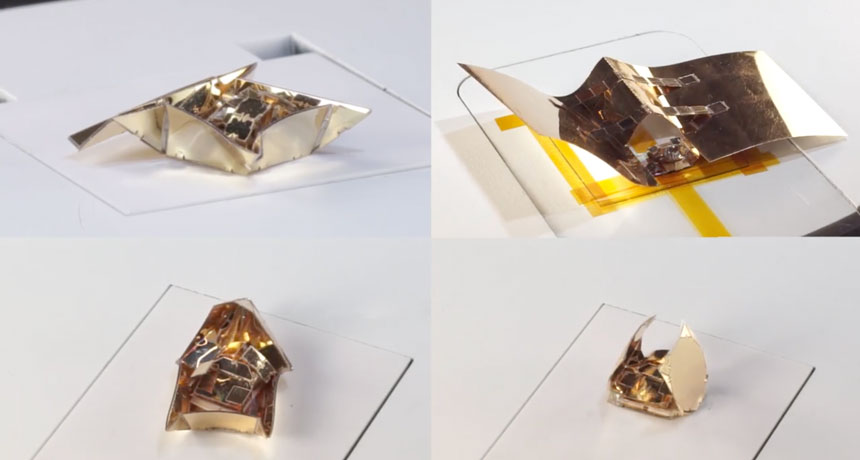Origami outfits help these bots change tasks swiftly

Robots are taking “dress for success” to a whole other level.
A new type of shape-shifting robot can undergo complete metamorphosis in a matter of minutes. The bot is composed of a simple metal cube that wraps itself in various high-tech origami sheets that fold into wings, wheels and other appendages for getting around. By donning and doffing different origami exoskeletons, the metal core can quickly switch from a walking to rolling to sailing bot and back again.
“It’s almost like putting clothes on the robot to give it different kinds of powers,” says study coauthor Daniela Rus, a roboticist at MIT. Such quickly customizable machines, described online September 27 in Science Robotics, could be useful for everything from surgery to space travel.
At the heart of each tiny transformer is a magnetic cube a few millimeters across, which Rus’ team “drove,” using magnetic coils of wire called solenoids as remote controls. To enclose this magnetic engine inside an origami body, the researchers parked the cube atop an unfolded origami sheet: a layer of the heat-shrinking material (the same kind used to make Shrinky Dinks) sandwiched between two panes of polyester. Along the fold lines, the researchers had peeled away strips of polyester to expose the shrinking film.
When the researchers cranked up a heating pad underneath the origami sheet to 65° Celsius, the heat-shrinking material along the creases contracted, causing the sheet to fold into a 3-D body, dubbed “Walk-bot,” that allowed the bot to amble. Rus’ team then used the same method to encompass the Walk-bot body inside other origami exoskeletons to create a bigger Walk-bot, Wheel-bot, Boat-bot, or Glider-bot.
Once the robot was all suited up, Rus and colleagues used the solenoids to make it walk or roll, sail on water or glide through the air. The outer exoskeletons were fastened into place with four latches made of water-soluble material, allowing Walk-bot to shuck its origami outerwear by getting these clasps wet. Then, leaving the used exoskeleton behind, Walk-bot could enfold itself in a new origami body. Future exoskeleton designs could arm robots with drills, scissors, shovels or grippers.
Such adaptable robots may be used for incision-free surgery, says Antoine Cully, a roboticist at Imperial College London who was not involved in the study. A patient could ingest a magnetic core and various exoskeletons, which a surgeon would then remotely control from outside the body. Shape-shifting robots could also be useful in other situations where they must perform a wide range of tasks without packing lots of spare parts, like during natural disaster emergency response operations or on space missions.
